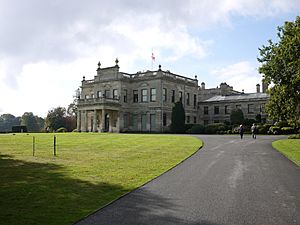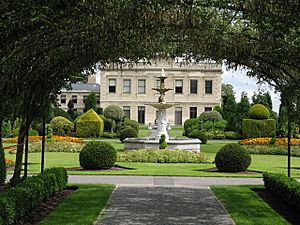Brodsworth Hall facts for kids
Quick facts for kids Brodsworth Hall |
|
|---|---|
 |
|
| Type | Country house |
| Location | Brodsworth |
| OS grid reference | SE 50595 07044 |
| Area | Doncaster |
| Built | 1861–1863 |
| Architect | Philip Wilkinson |
| Architectural style(s) | Italianate |
| Owner | English Heritage |
|
Listed Building – Grade I
|
|
| Official name: Brodsworth Hall | |
| Designated | 5 June 1968 |
| Reference no. | 1191614 |
| Lua error in Module:Location_map at line 420: attempt to index field 'wikibase' (a nil value). | |
Brodsworth Hall is a beautiful old country house near Brodsworth, about 5 kilometers (3 miles) north-west of Doncaster in South Yorkshire, England. It is one of the best examples of a Victorian country house that still looks much like it did when it was built in the 1860s. The house was designed in the Italianate style by a young architect named Philip Wilkinson. It is a very important building, listed as Grade I, which means it has special historical or architectural interest.
Contents
History of Brodsworth Hall
Early Owners and Changes
The Brodsworth estate was first bought by George Hay, 8th Earl of Kinnoull, in 1713. He rebuilt the house in the Georgian style. However, he lost a lot of money in a financial crash in 1720. His second son, Robert, who later became the Archbishop of York, lived on the estate and made many improvements.
After Robert's death in 1777, the house was empty for a while. In 1790, the estate was sold to Peter Thellusson (1737–1797). He was a banker from Geneva who had moved to England.
The Thellusson Family and Their Wealth
Peter Thellusson became a director of the Bank of England. In this role, he provided loans to people who owned ships and large farms in the Caribbean. When some of these owners could not pay back their loans, Thellusson gained ownership of parts of these farms. This meant he became involved in the trade of tobacco and sugar, which were produced using the labor of enslaved people.
Peter Thellusson wrote a very unusual will. He wanted his large fortune to be kept in a special trust and not touched for three generations. This will was challenged by his family in court but was upheld. Later, his grandson, Arthur Thellusson, married the daughter of another person who owned farms in Antigua where enslaved people worked. The Thellusson family continued to have connections to farms in Grenada and Montserrat that used enslaved labor as late as 1820.
Building the New Brodsworth Hall
One of the people who eventually received money from Peter Thellusson's will was his great-grandson, Charles Sabine Augustus Thellusson. In 1859, he inherited half of the money and the Brodsworth estate, which still had the old Georgian house. Charles decided to knock down the old house and build a brand new one. The current Brodsworth Hall was built very quickly, between 1861 and 1863.
Charles Sabine Augustus Thellusson loved sailing and even owned some of the largest yachts in the world. He was also an important local figure, serving as High Sheriff of Yorkshire from 1866 to 1867. He and his wife, Georgiana, had four sons. Sadly, all of their sons died without having children. This meant the house passed from one son to the next.
The third son, Charles Thellusson, made agreements for mining companies to dig for coal on the land. He also rented land for building Woodlands model village, which was a special village built for the miners and their families. He even paid for the construction of All Saints' Church in the village in 1913. He was also responsible for bringing electric lights to Brodsworth Hall.
Later Years and English Heritage
After the First World War, it became very expensive to keep up such a large house. The owners had to close off parts of it. When the youngest son, Augustus Thellusson, passed away in 1931, the house went to his nephew, Captain Charles Grant-Dalton. He also served as High Sheriff of Yorkshire from 1942 to 1943.
The last person to live in Brodsworth Hall was Sylvia Grant-Dalton, Captain Grant-Dalton's wife. For 57 years, she tried to fix the leaking roofs and deal with the ground sinking because of nearby coal mining. After she passed away in 1988, her daughter, Pamela Williams, gave the Hall and its gardens to English Heritage in 1990. The valuable items inside the house were bought by the National Heritage Memorial Fund and also given to English Heritage.
English Heritage decided not to completely restore the house. Instead, they chose to keep the interiors "as found." This means visitors can see how a grand Victorian house slowly aged and became a comfortable home over many years.
Exploring Brodsworth Hall
Architecture and Design
Brodsworth Hall was designed in the Italianate style by Philip Wilkinson. It is built from ashlar limestone, which is a type of cut stone, some of which came from the estate itself. The roofs are made of lead and slate. Interestingly, some of the stone, windows, and inside decorations were reused from the older house that stood there before.
The building is shaped like a "T," with the servants' areas forming the upright part. The main part of the house, where the family lived, is a two-story rectangular building with nine sections across the front. The house has more than 30 rooms. These range from fancy reception rooms with their original furniture to the areas where the servants worked.
Gardens and Collections
The house is surrounded by beautiful Victorian gardens. These gardens are often used for special events, especially during the summer months.
Brodsworth Hall is also known for the amazing collection of paintings and sculptures that Charles Sabine Thellusson gathered. This includes a large number of Italian sculptures that he bought at a big exhibition in Dublin in 1865.
See also
- Grade I listed buildings in South Yorkshire
- Listed buildings in Brodsworth


